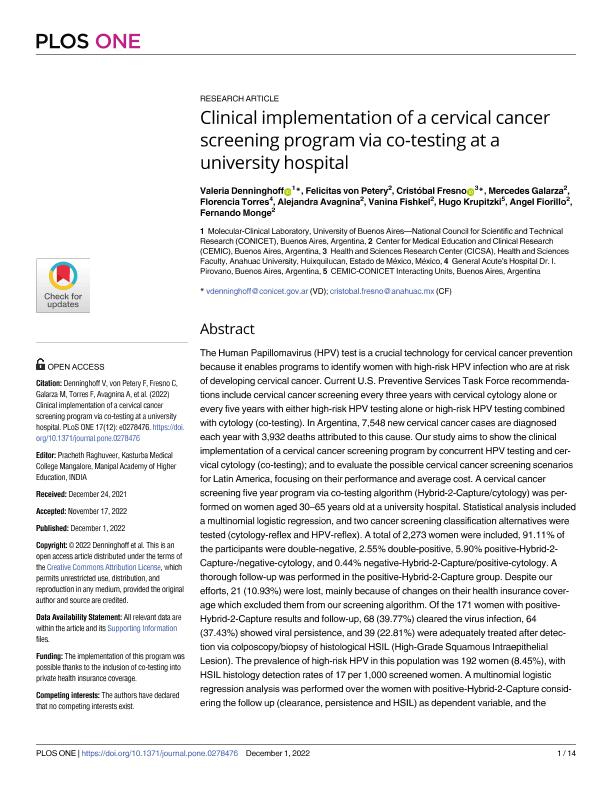Artículo
Clinical implementation of a cervical cancer screening program via co-testing at a university hospital
Denninghoff, Valeria Cecilia ; von Petery, Felicitas; Fresno, Cristóbal; Galarza, Mercedes; Torres, Florencia; Avagnina, Alejandra; Fishkel, Vanina; Krupitzki, Hugo Bernardo
; von Petery, Felicitas; Fresno, Cristóbal; Galarza, Mercedes; Torres, Florencia; Avagnina, Alejandra; Fishkel, Vanina; Krupitzki, Hugo Bernardo ; Fiorillo, Angel Eduardo; Monge, Fernando Carlos
; Fiorillo, Angel Eduardo; Monge, Fernando Carlos
 ; von Petery, Felicitas; Fresno, Cristóbal; Galarza, Mercedes; Torres, Florencia; Avagnina, Alejandra; Fishkel, Vanina; Krupitzki, Hugo Bernardo
; von Petery, Felicitas; Fresno, Cristóbal; Galarza, Mercedes; Torres, Florencia; Avagnina, Alejandra; Fishkel, Vanina; Krupitzki, Hugo Bernardo ; Fiorillo, Angel Eduardo; Monge, Fernando Carlos
; Fiorillo, Angel Eduardo; Monge, Fernando Carlos
Fecha de publicación:
12/2022
Editorial:
Public Library of Science
Revista:
Plos One
ISSN:
1932-6203
Idioma:
Inglés
Tipo de recurso:
Artículo publicado
Clasificación temática:
Resumen
The Human Papillomavirus (HPV) test is a crucial technology for cervical cancer prevention because it enables programs to identify women with high-risk HPV infection who are at risk of developing cervical cancer. Current U.S. Preventive Services Task Force recommendations include cervical cancer screening every three years with cervical cytology alone or every five years with either high-risk HPV testing alone or high-risk HPV testing combined with cytology (co-testing). In Argentina, 7, 548 new cervical cancer cases are diagnosed each year with 3, 932 deaths attributed to this cause. Our study aims to show the clinical implementation of a cervical cancer screening program by concurrent HPV testing and cervical cytology (co-testing); and to evaluate the possible cervical cancer screening scenarios for Latin America, focusing on their performance and average cost. A cervical cancer screening five year program via co-testing algorithm (Hybrid-2-Capture/cytology) was performed on women aged 30-65 years old at a university hospital. Statistical analysis included a multinomial logistic regression, and two cancer screening classification alternatives were tested (cytology-reflex and HPV-reflex). A total of 2, 273 women were included, 91.11% of the participants were double-negative, 2.55% double-positive, 5.90% positive-Hybrid-2Capture-/negative-cytology, and 0.44% negative-Hybrid-2-Capture/positive-cytology. A thorough follow-up was performed in the positive-Hybrid-2-Capture group. Despite our efforts, 21 (10.93%) were lost, mainly because of changes on their health insurance coverage which excluded them from our screening algorithm. Of the 171 women with positive-Hybrid-2-Capture results and follow-up, 68 (39.77%) cleared the virus infection, 64 (37.43%) showed viral persistence, and 39 (22.81%) were adequately treated after detection via colposcopy/biopsy of histological HSIL (High-Grade Squamous Intraepithelial Lesion). The prevalence of high-risk HPV in this population was 192 women (8.45%), with HSIL histology detection rates of 17 per 1, 000 screened women. A multinomial logistic regression analysis was performed over the women with positive-Hybrid-2-Capture considering the follow up (clearance, persistence and HSIL) as dependent variable, and the cytology test results (positive- or negative-cytology and Atypical Squamous Cells of Undetermined Significance, ASC-US) as independent variable. The model supported a direct association between cytology test results and follow up: negative-cytology/clearance, ASC-US/persistence, and positive-cytology/HSIL with the following probabilities of occurrence for these pairs 0.5, 0.647 and 0.647, respectively. Cytology could be considered a prognostic-factor in women with a positive-Hybrid-2-Capture. These findings suggest that the introduction of co-testing could diminish the burden of cervical cancer in low-and middle-income-countries, acting as a tool against inequity in healthcare.
Palabras clave:
CERVICAL CANCER
,
UNIVERSITY HOSPITAL
Archivos asociados
Licencia
Identificadores
Colecciones
Articulos(CEMIC-CONICET)
Articulos de CENTRO DE EDUCACION MEDICA E INVESTIGACIONES CLINICAS "NORBERTO QUIRNO"
Articulos de CENTRO DE EDUCACION MEDICA E INVESTIGACIONES CLINICAS "NORBERTO QUIRNO"
Citación
Denninghoff, Valeria Cecilia; von Petery, Felicitas; Fresno, Cristóbal; Galarza, Mercedes; Torres, Florencia; et al.; Clinical implementation of a cervical cancer screening program via co-testing at a university hospital; Public Library of Science; Plos One; 17; 12-2022; 1-14
Compartir
Altmétricas



